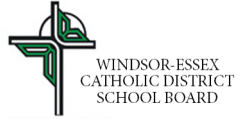School strikes raising concerns

Windsor-Essex Catholic District School Board. File photo courtesy of The Mediaplex.
Students, parents and teachers have rising concerns about the school strikes happening across Ontario.
Local schools saw several rounds of strikes in the elementary, secondary and French school boards in the first six weeks of 2020. According to the Ontario Secondary School Teachers’ Federation, education workers and teachers represented by the OSSTF in certain school boards, such as the Greater Essex County District School Board, took part in another one-day full withdrawal of services Feb. 13.
Courtney Scratch, a high school teacher at Westview Freedom Academy, said striking is an unfortunate necessity.
“I don’t enjoy striking but I believe it is necessary. It’s really unfortunate that it has come to this,” said Scratch. “When the cuts to education were announced last March by then minister of education Lisa Thompson, teachers, support staff, educators around the province immediately began to rally.”
Scratch also said there was a rally at Queen’s Park in April 2019 and since then there have been steady campaigns. The work-to-rule campaign was started by teachers to put pressure on the government in terms of bargaining. It is a job action in which employees do no more than the minimum work required by the rules of their contract.
In a statement made by Premier Doug Ford, he said the government is working hard to reach a fair deal.
“We’re doing everything we can. We want to negotiate a fair deal. A fair deal that will keep the students in the class, not hurt the students by walking out. Not hurting parents by walking out. Not hurting the economy,” said Ford. “It probably costs hundreds of millions of dollars talking to business owners when their employees don’t show up because the teachers would rather go on strike for a day.”
Ford also said that they were able to reach a deal with other unions, such as the Canadian Union of Public Employees, and are asking themselves why they cannot reach a deal with other unions, such as the OSSTF.
“Why isn’t it good enough for the head of the unions? And I always differentiate between the teachers and their union heads,” said Ford. “I support the hardworking men and women that teach our children every single day. I think they don’t have good leadership. The head of the unions want to argue no matter what premier, no matter what government is in power.”
Grace Talbot, a Grade 12 student at General Amherst High school, said the strikes have already affected the new semester, which started Jan. 31.
“My teacher, he is supposed to have done all of his review from last year by now, but it hasn’t been done because we already missed a day and we’re going to miss another one, so he is trying to cram it in,” said Talbot.
Shan Bailey, a mother of three boys has two of them in school. She said the strikes are appropriate action but have affected her sons’ studies.
“I think a general strike of solidarity from national union support for all issues is a necessary measure. However, Jaymz is in Grade 9 and Junior is in Grade 1, which are both highly transitional years in academics that require a village’s support for success,” said Bailey. “Junior is showing all signs of bordering struggles with transition to Grade 1. As a result of scheduling, backlog and cuts disjointing the child mental health supports, it is becoming impossible to access the screening for an independent education plan to support him.”
The Elementary Teachers’ Federation of Ontario represents 83,000 teachers. The ETFO president said in a media release posted to their website the rotating strike days continued into the second week of February in hopes the government and minister of education will return to talks “prepared to support public education.”


